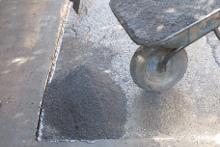

 |
ESTOL-Joint Tape Application ESTOL-Joint Tape for fusing asphalt layers in a vertical connection range, for road installations or sealing concrete pipes. It complies with ZTV Fug-StB01. |
|
Application1. In road construction to seal edge joints and construction joints: Lasting sealing between poured concrete and/or roller-compacted asphalts and concrete pavements on roads and bridges. Lasting sealing of asphalt tracks with one another, e.g. hard shoulders to traffic lanes, for flawless repair seals and ruptured areas. PropertiesESTOL-Joint Tape has plasto-elastic properties and good adhesive properties that mostly correspond to hot casting compounds for road and channel construction. ESTOL-Joint Tape is stable and packed true-to-form in order to enable convenient and easy handling at any occurring installation temperature, and it is resistant to traffic and weather influences. The bituminous basic mixture used corresponds to our joint and sleeve casting compounds in its stretching and adhesive properties, especially due to the addition of elastomers, as we have developed them based on decades of experience. Processing-InformationPrimer K must be applied on a clean and dust free surface. The tape profiles are stuck on using Primer K. It is structured on the principle of a contact adhesive so that flawless adhesion is possible after the necessary full evaporation of the contained solvents. Before pressing on the tape it should be heated using a propane gas flame. ProcessingAdhesion to the already existing joint flank and the new asphalt layer and/or concrete part is done by fusing with the joint tape. Experience has shown that the temperature of the asphalt layer being installed is sufficient to heat a 10 mm tape continuously to +120 °C and thereby melt it flawlessly. Our tape is configured for this. The main difference between the installation of plasto-elastic joint tapes and joint sealing compounds is that the joint tape is laid before the bituminous layer is installed while conventional joint sealing compounds are applied afterwards. |
||



